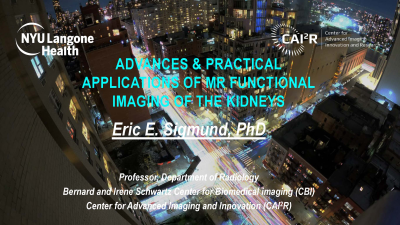Weekend Course
Genitourinary Imaging: Basics to the Latest in Prostate Imaging with Updates in Renal, Adrenal & Bladder Imaging
ISMRM & ISMRT Annual Meeting & Exhibition • 03-08 June 2023 • Toronto, ON, Canada

| 13:15 | How to Approach the Post-Treatment Prostate Chan Kyo Kim | |
| 13:40 |
How to Get the Most from Your MR Machine for Prostate Imaging
Moon Hyung Choi
Keywords: Body: Pelvis Given the increasing number of prebiopsy prostate MRIs and the changing role of prostate MRI, we would like to discuss ways to obtain images that are helpful for interpretation while maintaining image quality and acquiring them quickly. Compressed sensing (CS) and deep learning-based image reconstruction (DLR) are used to improve the speed and quality of MRI imaging. For diffusion weighted imaging, multi-shot or segmented DWI and calculated high b value DWI images are useful. It is essential to stay updated on new techniques, to get the most out of MRI machines. |
|
| 14:05 |
 |
Artificial Intelligence for the Prostate: What Can It Do & Where
Is It Going?
Maarten de Rooij
Keywords: Body: Urogenital This presentation will highlight the clinical challenges of the diagnostic MRI-driven pathway for prostate cancer and the role that Artificial Intelligence can play to overcome these challenges. In the current literature/clinical practice, AI is mainly used in the interpretation phase of the diagnostic pathway. In the future, AI will also play a role in other stages of this pathway; from the pre-imaging until the patient management stage. |
| 14:30 |
What do PSMA & PET Add to the Prostate Game?
Ali Pirasteh
Keywords: Body: Urogenital, Contrast mechanisms: Molecular imaging Prostate-specific membrane antigen-targeted positron emission tomography (PSMA PET) has made a significant impact on management of patients with prostate cancer. Compared to conventional cross-sectional imaging, PSMA PET provides superior sensitivity for tumor detection in the setting of biochemical recurrence as well as for detection of metastatic disease in those with high-risk disease. PSMA PET is also used to determine eligibility for treatment with radioligand PSMA-directed therapy, which has been demonstrated to improve survival. We will review the added value of PSMA PET in management of patients with prostate cancer and its synergistic role with MRI in this setting. |
|
| 14:55 |
Break & Meet the Teachers |
|
| 15:20 |
MR Approach the Renal Mass: When to Watch, When to Cut & When to
Biopsy
Refky Nicola
Keywords: Body: Kidney, Body: Urogenital, Education Committee: Clinical MRI
Discuss: The
definition & prevalence of the indeterminate renal masses
(IRM) Review: MRI features of IRM |
|
| 15:45 |
 |
Advances & Practical Applications of MR Functional Imaging of
the Kidneys
Eric Sigmund
Keywords: Body: Kidney, Contrast mechanisms: Microstructure, Contrast mechanisms: Perfusion Renal function and pathology in a wide variety of contexts (healthy filtration, chronic kidney disease, allograft function) can be sensitized and monitored with the wide armamentarium of tools provided by quantitative MRI. These measures probe microstructure (DWI, elastography), microcirculation/hemodynamics (ASL, DCE, PC-MRI), and oxygenation (BOLD), among others. For each of these approaches there have developed both translational efforts of harmonization (to generate standardizable variants to escalate multi-site evidence generation and incorporation into clinical trials), and innovation (to explore and validate each MR contrast and its relationship to tissue function). This talk will briefly summarize these two branches of work. |
| 16:10 | The Adrenals Are Part of the GU Tract, Too: Don’t Forget About Us Anju Sahdev |
The International Society for Magnetic Resonance in Medicine is accredited by the Accreditation Council for Continuing Medical Education to provide continuing medical education for physicians.